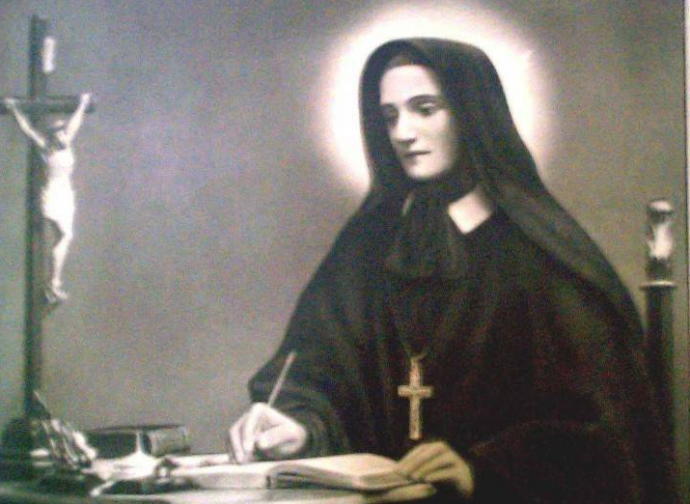Saint Mary Di Rosa
She had a vocation to sanctity since her childhood. Her profound devotion to the Eucharist inspired the attentions she would show towards the needy of all kinds. After her death, the saint acted as a guide to Pierina Gilli during the first apparition of Mary as the Mystical Rose - a Marian vision with strong Eucharistic contents, which the Church is studying today

That the foundress of the Handmaids of Charity, Saint Mary Di Rosa (1813-1855), had a vocation to sanctity was obvious since her childhood. The sixth of nine children, she was born in Brescia to noble and pious parents, who baptised her Paola Francesca Maria.
A particular event can help us understand the love that Paolina (as she was called as a child) felt for God, as well as the deep faith she had acquired through her family. After her Confession and Confirmation in 1820, the child, as we read in her Posito, "confessed to her mother that she envied her when she saw her receive the Eucharist. [...] Then her mother taught her the spiritual Communion, which Paola used in order to be close to Jesus. (...) She did this not only every day but even more frequently, delighting in Visits to Jesus in the Blessed Sacrament, which were immediately included as her favourite item into the rule of life she set for herself at 8 years old.”
Her profound devotion to the Eucharist, which she received for the first time on Easter Day, 1823, inspired the attentions she would show towards the needy of all kinds. When she was 11 her mother died, and her father sent her to a boarding school run by the Visitation Sisters, where, not being satisfied with the short daily visits she and her school friends made to the Blessed Sacrament, Paola asked and obtained permission to spend half an hour before the tabernacle. According to the documents of her beatification cause, «once asked by the schoolmaster what she said to the Lord on those occasions, she answered naively: “I ask for something to suffer”».
After leaving the school, Paola returned to her family, declining a possible marriage offer and, at less than 18 years old, she took a vow of perpetual virginity. Around that time she began to look after the women working in her father's spinning mill, and tried to meet the material and spiritual needs of the poor. In 1836 cholera broke out in Brescia, claiming a huge number of victims: feeling called by God, and advised by her spiritual director (Monsignor Pinzoni), Paola asked her father permission to assist the women affected by the epidemic. Her father consented, and on June 24th Paola, together with the aristocratic Gabriella Echenos Bornati (1798-1844), entered the Brescia hospital.
Months later the cholera ended, but their experience would form the basis for the establishment, four years later, of the Pious Union of the Handmaids of Charity: Paola (as the superior), Gabriella (as vice superior) and 30 other companions officially began their service at the Brescia women's hospital on May 18th, 1840. The Handmaids soon spread to other Italian cities and abroad: to her daughters in Christ Paola always stressed the crucial importance of Eucharistic adoration. Having obtained the Pope's, and then the Emperor's, approval, the Union became a religious congregation and, on June 18, 1852, Paola took the habit with the name of Mary di Rosa.
The saint was called to the eternal encounter with her Spouse on December 15, 1855, at the age of 42. One day earlier, she had written in her spiritual testament: "What I recommend to you, children, is great charity. Be charitable first to one another, then to the poor sick women. In your work, only aim for the glory of the Lord; you should work for Him and Him alone; while assisting the sick, consider not the creature but the Lord's own Person. Give all the prescribed time to the exercises of piety. Be accurate in the observance of the holy Rules, down to the last minute. Take care of even the smallest things, especially any lack of charity. God bless you!"
A century later, in 1944, Sister Mary di Rosa appeared to Pierina Gilli (1911-1991), the Visionary of Montichiari, then a postulant with the Handmaids of Charity and in quarantine for meningitis, bringing her healing. And again two years later, on November 24th, Maria di Rosa first acted as a guide to Pierina during the first apparition of Mary as the Mystical Rose - a Marian vision with strong Eucharistic contents, which the Church is studying today - revealing that the Lady she saw was the Holy Virgin, and that the three swords piercing the place of her Immaculate Heart had a precise meaning: «First: for the religious souls who betray their vocation. Second: to make reparation for the mortal sin of these souls. Third: to make reparation for the betrayal of priests who make themselves unworthy of their sacred ministry. Particularly – Pierina wrote – she recommended the sanctification of priests, by saying to me: "If these are saints, so many souls will be sanctified"».
Prayer, sacrifice and penance are required for cooperating with the divine plan.




